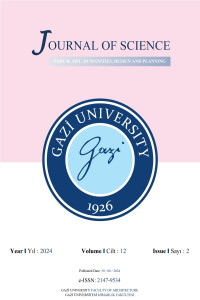Abstract
References
- [1] Agnoli, S., Runco, M.A., Kirsch, C. & Corazza, G.E. (2018). The role of motivation in the prediction of creative achievement inside and outside of school environment. Thinking Skills and Creativity, 28, 167-176, doi.org/10.1016/j.tsc.2018.05.005
- [2] Agogué, M., Kazakçi, A., Hatchuel, A., Masson, P. L., Weil, B., Poirel, N. & Cassotti, M. (2013). The Impact of Type of Examples on Originality: Explaining Fixation and Stimulation Effects. The Journal of Creative Behavior 48 (1), 1–12. doi.org/10.1002/jocb.37
- [3] Alcaide – Marzal J, Diego – Mas J. & Acosta – Zazueta G. (2020). A 3D Shape Generative Method for Aesthetic Product Design. Design Studies, 66, 144-176. doi.org/10.1016/j.destud.2019.11.003
- [4] Amabile, T. M. (1997). Motivating Creativity in Organizations: On Doing What You Love and Loving What You Do. California Management Review, 40(1), 39-58. doi.org/10.2307/41165921
- [5] Archer, L. B. (1965). Systematic Method for Designers. London, The Design Council.
- [6] Armağan Y. (2019). Artificial Intelligence in Furniture Design: An Evaluation on Design and R&D Centers, master’s Thesis, Hacettepe University Institute of Fine Arts Department of Interior Architecture and Environmental Design, Ankara
- [7] Bar, M. (2007). The Proactive Brain: Using Analogies and Associations to Generate Predictions. Trends in Cognitive Sciences, 11(7), 280-289 doi.org/10.1016/j.tics.2007.05.005
- [8] Bidgoli, A. and Veloso, P. (2018). Deepcloud the application of a data-driven, generative model in design. ACADIA 2018: Proceedings of the 38th Annual Conference of the Association for Computer Aided Design in Architecture, 176-185. doi.org/10.48550/arXiv.1904.01083
- [9] Boğa, M. (2013). Natural Analogy in Design: A Study on the Approach of Industrial Design Students, Master Thesis, Istanbul Technical University, Institute of Science, İstanbul
- [10] Boudier, J., Sukhov, A., Netz, J., Le Masson, P., & Weil, B. (2023). Idea evaluation as a design process: understanding how experts develop ideas and manage fixations. Design Science, 9, e9. doi:10.1017/dsj.2023.7
Investigating The Effects of Using Artificial Intelligence in The Conceptual Design Phase of The Industrial Design Process
Abstract
This article offers a perspective on the use of artificial intelligence software as an auxiliary tool in the design process and the positive and negative effects of its application. For this purpose, the potential of the MidJourney tool based on artificial intelligence to support creativity and motivation in the product design process was tested with design students. In the workshop with design students, it was determined that artificial intelligence can support the creative thinking process in terms of form and aesthetics by creating the outlines of design concepts and supporting the creative thinking process in terms of form and aesthetics and can also contribute positively to the student's time management. As a result of the analysis and interpretation of the workshop, positive results were obtained, like other studies that refute the existing negative prejudice against artificial intelligence. However, it is understood that there is a need to explain to the students how such platforms should be used and that the current concerns should be eliminated by raising students' awareness about the future of artificial intelligence. On the one hand, it will negatively affect unconscious student profiles or people who are accustomed to the ready-made design process and their creativity.
References
- [1] Agnoli, S., Runco, M.A., Kirsch, C. & Corazza, G.E. (2018). The role of motivation in the prediction of creative achievement inside and outside of school environment. Thinking Skills and Creativity, 28, 167-176, doi.org/10.1016/j.tsc.2018.05.005
- [2] Agogué, M., Kazakçi, A., Hatchuel, A., Masson, P. L., Weil, B., Poirel, N. & Cassotti, M. (2013). The Impact of Type of Examples on Originality: Explaining Fixation and Stimulation Effects. The Journal of Creative Behavior 48 (1), 1–12. doi.org/10.1002/jocb.37
- [3] Alcaide – Marzal J, Diego – Mas J. & Acosta – Zazueta G. (2020). A 3D Shape Generative Method for Aesthetic Product Design. Design Studies, 66, 144-176. doi.org/10.1016/j.destud.2019.11.003
- [4] Amabile, T. M. (1997). Motivating Creativity in Organizations: On Doing What You Love and Loving What You Do. California Management Review, 40(1), 39-58. doi.org/10.2307/41165921
- [5] Archer, L. B. (1965). Systematic Method for Designers. London, The Design Council.
- [6] Armağan Y. (2019). Artificial Intelligence in Furniture Design: An Evaluation on Design and R&D Centers, master’s Thesis, Hacettepe University Institute of Fine Arts Department of Interior Architecture and Environmental Design, Ankara
- [7] Bar, M. (2007). The Proactive Brain: Using Analogies and Associations to Generate Predictions. Trends in Cognitive Sciences, 11(7), 280-289 doi.org/10.1016/j.tics.2007.05.005
- [8] Bidgoli, A. and Veloso, P. (2018). Deepcloud the application of a data-driven, generative model in design. ACADIA 2018: Proceedings of the 38th Annual Conference of the Association for Computer Aided Design in Architecture, 176-185. doi.org/10.48550/arXiv.1904.01083
- [9] Boğa, M. (2013). Natural Analogy in Design: A Study on the Approach of Industrial Design Students, Master Thesis, Istanbul Technical University, Institute of Science, İstanbul
- [10] Boudier, J., Sukhov, A., Netz, J., Le Masson, P., & Weil, B. (2023). Idea evaluation as a design process: understanding how experts develop ideas and manage fixations. Design Science, 9, e9. doi:10.1017/dsj.2023.7
Details
| Primary Language | English |
|---|---|
| Subjects | Industrial Product Design |
| Journal Section | Industrial Design |
| Authors | |
| Publication Date | June 30, 2024 |
| Submission Date | February 5, 2024 |
| Acceptance Date | June 14, 2024 |
| Published in Issue | Year 2024 Volume: 12 Issue: 2 |

